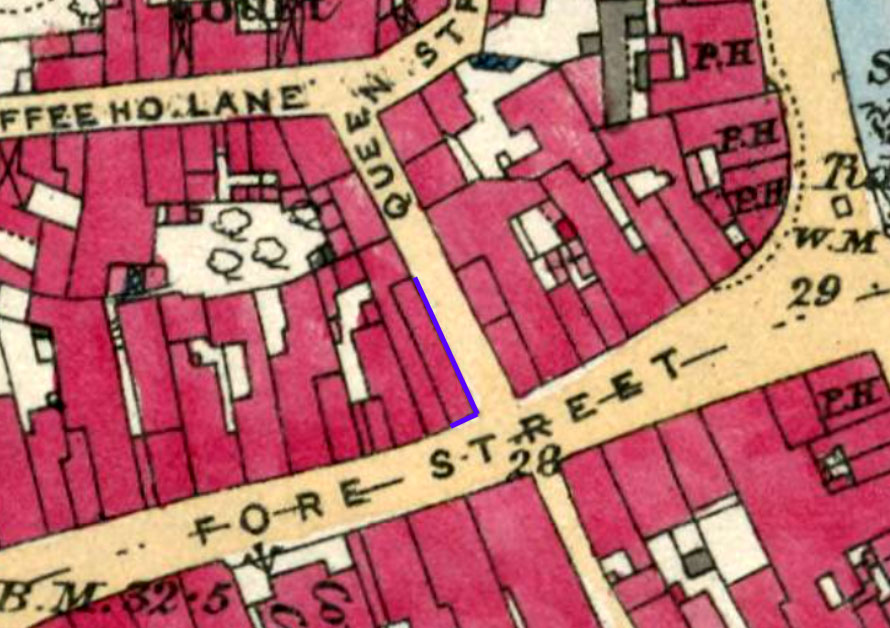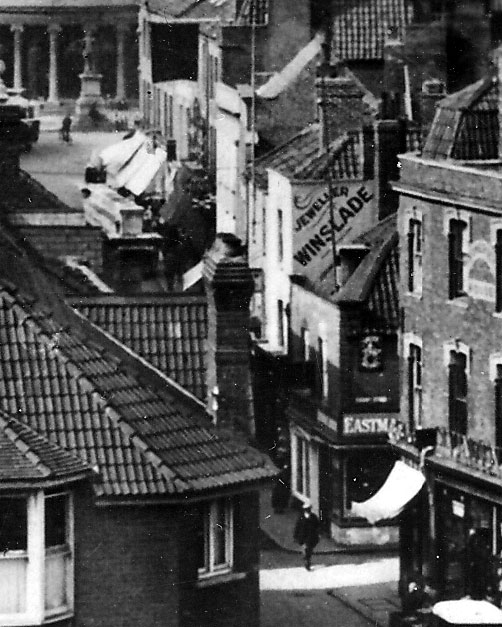This page relates the terrible discovery of human remains in 18 Fore Street.

It is likely that the building seen here contains the two properties on the map above that join onto this corner.
Taunton Courier and Western Advertiser 8 July 1931.
GRUESOME DISCOVERY: SKELETON OF BABY IN CHIMNEY. REVEALED BY DEMOLITION WORK.
A gruesome discovery was made at Bridgwater on Friday afternoon, the remains of an infant being found in a chimney shaft at premises on the comer of Fore-street and Court-street. The buildings are now under-going demolition preparatory to the erection of a number of new shops and it was while this work was in progress that the discovery was made by Herman Mitchell, of Silver-street, an employee of the contractors, Messrs. C. Bryer & Son, Ltd.
The remains were in a very decomposed condition, being practically only the skeleton of the child, and it is thought that they must have been there for some years. Apparently the remains were those of a child which at the time of its death, had not long been born. The remains were later taken to the mortuary to await an inquest. Until recently the corner shop was occupied by Messrs. Eastman, Ltd., butchers, and the other shop by a printer and stationer.
JURY RETURN OPEN VERDICT. REMAINS PROBABLY 50 YEARS OLD.
An open verdict was returned by the jury at the Inquest on the remains, which was held by the Coroner for the borough (Mr. Arthur King) at the Court House on Tuesday after-noon. Mr. C. L. Fisher was chosen foreman of the jury.
The Coroner explained that the jury were called together to enquire into what was nothing more or less than the skeleton of a very young child which was found in the chimney of house being demolished on the corner of Court street and Fore-street. On Friday Mr. Mitchell, bricklayer’s labourer, was working on the demolition of the building, and discovered in the chimney or flue in an attic or upstair room a bundle which was lodged in the chimney about 15 or 18 inches above the fireplace. He took the bundle out and found it was some old linen, an old apron he (the Coroner) thought, with something wrapped up in it. On looking inside he found there was a number of bones, which seemed to be the skeleton of a very young child. Both bones an cloth were somewhat decayed, and appeared to have been in the chimney for a long time. It appeared to Mitchell that the remains had been pushed up the chimney, not that the chimney had been built around them. The matter was reported to the police, and he (the Coroner) saw the remains. He had also obtained a report upon them from Dr. G. W. Harvey Bird, in which he stated that the remains were those of an infant, and consisted of the skeleton only. Much of it was reduced to powder, but it contained portions of the skull and many other entire portions wrapped in what appeared to be an apron. Judging by the skull he was of opinion the remains were those of a newly-born child, possibly premature, but of which sex it was impossible to determine. It was impossible to say whether the child had a separate existence, and if it had, what was the cause of its death. “In my opinion,” the report concluded, “the body has been in the place where it was found for very many years, possibly 50 or more”.
Herman Mitchell, bricklayer’s labourer of 29, Silver-street, gave evidence that at about 3 p.m. on Friday he was engaged in demolishing a building at the corner of Fore-street and Court-street, when he discovered a bundle in the chimney or flue of the fireplace in a room on the second floor. The bundle was about 15 or 18 inches above the fireplace. Witness took it out, and found it consisted of some linen material wrapped round a number of bones, which appeared to be part of the skeleton of a very young child. Both the cloth and bones were decayed, and they appeared to have been there a long time. He informed the police, who removed the remains. The Coroner said that was all the evidence they could get; nobody could tell them anything about it. He did not think there was anything the jury could do except return an open verdict that the body of an unknown child of unknown sex was found, but there was no evidence to show how it came by its death.
The jury agreed, the foreman remarking it was the only possible verdict.
NOTES on the building
An entrance to Court Street is shown as early as 1735. This property was built over the moat of the old castle. On the 1810s town plan, this property along with the next (number 20) seem to have been one plot.

